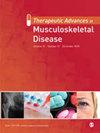类风湿性关节炎间质性肺病的风险因素:来自 KOBIO 登记处的一项队列研究
IF 4.1
2区 医学
Q2 RHEUMATOLOGY
引用次数: 0
摘要
间质性肺病(ILD)是类风湿性关节炎(RA)的一个重要关节外表现。然而,人们对 RA-ILD 的风险因素知之甚少。在此,我们利用韩国风湿病学会生物制剂和靶向治疗(KOBIO)登记研究了人口、临床、治疗和环境因素对 RA 患者 ILD 发病率的影响。我们使用的数据来自 KOBIO 登记,这是一个多中心、前瞻性、观察性队列,包括韩国的 RA 患者。我们对使用生物制剂或靶向合成改善病情抗风湿药(b/tsDMARDs)或传统合成(cs)DMARDs,并加入 KOBIO 登记的 RA 患者进行了研究。研究人员在基线时记录了人口统计学特征、临床特征、放射学特征以及用药情况,此后每年记录一次。采用卡普兰-梅耶曲线和对数秩检验来比较服用不同b/tsDMARDs的RA患者的ILD发生率。通过 Cox 回归分析计算危险比(HRs)。共分析了2492名患者(b/tsDMARDs组1967人,csDMARDs组525人)。与csDMARDs组相比,b/tsDMARDs组的病程更长,红细胞沉降率/反应蛋白更高,疾病活动度评分-28(DAS28)更高。服用肿瘤坏死因子抑制剂和阿帕他赛的患者的ILD发病率明显高于服用csDMARDs的患者(对数秩p < 0.001)。多变量考克斯回归分析发现,年龄较大(HR = 1.057,p = 0.001)、性别为男性(HR = 2.824,p = 0.007)、时间平均DAS28(HR = 2.241,p < 0.001)和类风湿因子滴度(HR = 1.009,p = 0.007)会显著增加ILD发生的HR。ILD是RA患者一种罕见但严重的关节外症状。因此,具有上述危险因素的 RA 患者应仔细监测 ILD 的发生。本文章由计算机程序翻译,如有差异,请以英文原文为准。
Risk factors for interstitial lung disease in rheumatoid arthritis: a cohort study from the KOBIO registry
Interstitial lung disease (ILD) is a critical extra-articular manifestation of rheumatoid arthritis (RA). However, little is known about the risk factors of RA-ILD. Here, we examined the effect of demographic, clinical, therapeutic, and environmental factors on the incidence of ILD in RA patients using the Korean College of Rheumatology Biologics and Targeted Therapy (KOBIO) registry. We used data from the KOBIO registry, a multi-center, prospective, observational cohort that included RA patients in South Korea. RA patients who used biologic or targeted synthetic disease-modifying antirheumatic drugs (b/tsDMARDs) or conventional synthetic (cs)DMARDs, and were enrolled in the KOBIO registry, were examined. Demographic, clinical, and radiographic characteristics, as well as medications, were recorded at baseline and annually thereafter. Kaplan–Meier curves and the log-rank test were used to compare the incidence of ILD between RA patients taking different b/tsDMARDs. Hazard ratios (HRs) were calculated by Cox regression analyses. In total, 2492 patients (1967 in the b/tsDMARDs group and 525 in the csDMARDs group) were analyzed. The b/tsDMARDs group showed longer disease duration, higher erythrocyte sedimentation rate/C-reactive protein, and higher disease activity score-28 (DAS28) than the csDMARDs group. The incidence of ILD was significantly higher in those taking tumor necrosis factor inhibitors and abatacept than in those taking csDMARDs (log ranked p < 0.001). Multivariate Cox regression analysis identified older age (HR = 1.057, p = 0.001), male sex (HR = 2.824, p = 0.007), time-averaged DAS28 (HR = 2.241, p < 0.001), and rheumatoid factor titer (HR = 1.009, p = 0.007) as having a significantly increased HR for ILD occurrence. ILD is a rare but critical extra-articular symptom of RA patients. Therefore, RA patients with the above risk factors should be monitored carefully for ILD development.
求助全文
通过发布文献求助,成功后即可免费获取论文全文。
去求助
来源期刊

Therapeutic Advances in Musculoskeletal Disease
Medicine-Rheumatology
CiteScore
6.80
自引率
4.80%
发文量
132
审稿时长
18 weeks
期刊介绍:
Therapeutic Advances in Musculoskeletal Disease delivers the highest quality peer-reviewed articles, reviews, and scholarly comment on pioneering efforts and innovative studies across all areas of musculoskeletal disease.
 求助内容:
求助内容: 应助结果提醒方式:
应助结果提醒方式:


